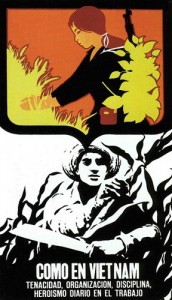 My path into agrarian political economy and ecology partly picks up where Marx left off. In culminating his magnum opus, Marx departs from his more dualistic model of the capitalist mode of production, which emphasizes the dialectic of labor-and-capital, by adding a third element: land (Ch. 48, Vol. III). While human labor and the earth are universal factors of production—though historically changing—capital-interest-profit is peculiar to the monstrous world of the capitalist mode of production. With his trinity formula, Marx adds greater conceptual depth to how the capitalist labor process induces an insatiable metabolism between nature and society (Vol I. Ch. 7)—and, in fact, their “irreparable rift” (Vol. III:949). His insights also demand that we place more conceptual and political focus on agrarian struggles in seeking more just and sustainable social relations. Among many other things, political ecology has sought to extend Marx’s unfortunately brief ending to Das Kapital, particularly since agriculture and the politics of resources have posed confounding conceptual problems for critical political economists. But political ecology has done more than simply “fill” gaps; by broadening the scope of critical research on socio-natural interactions it has raised new gaps and new questions.
My path into agrarian political economy and ecology partly picks up where Marx left off. In culminating his magnum opus, Marx departs from his more dualistic model of the capitalist mode of production, which emphasizes the dialectic of labor-and-capital, by adding a third element: land (Ch. 48, Vol. III). While human labor and the earth are universal factors of production—though historically changing—capital-interest-profit is peculiar to the monstrous world of the capitalist mode of production. With his trinity formula, Marx adds greater conceptual depth to how the capitalist labor process induces an insatiable metabolism between nature and society (Vol I. Ch. 7)—and, in fact, their “irreparable rift” (Vol. III:949). His insights also demand that we place more conceptual and political focus on agrarian struggles in seeking more just and sustainable social relations. Among many other things, political ecology has sought to extend Marx’s unfortunately brief ending to Das Kapital, particularly since agriculture and the politics of resources have posed confounding conceptual problems for critical political economists. But political ecology has done more than simply “fill” gaps; by broadening the scope of critical research on socio-natural interactions it has raised new gaps and new questions.
Kautsky’s “agrarian question,” including nature more broadly, was trail blazing in its consideration of three interrelated empirical queries: the ways in which capitalism shapes the contours of agrarian society; the role of agriculture in capitalist development; and, finally, a political question about the role of peasants in building radically new societies (Kautsky 1988). Contrary to the theoretical orthodoxy of his time, Kautsky finds no evidence for small-scale agriculture’s inevitable withering away; by all indications, in fact, he realized the borderline survival and semi-proletarianization of the peasantry can be entirely compatible with—and even conducive to—agro-industrial farming. Lenin (1977) similarly finds that capitalist agricultural development produces an increasingly complex division of labor and peasant differentiation. More so than Lenin, Kautsky grapples with how agricultural production is qualitatively different from industry in a capitalist system. For instance, land cannot be produced or moved like machinery; peasant labor-power (both in the household and in the field) is not necessarily valorized in the market; and infinite concentration and centralization of land can actually become counter-productive. Landed production’s relation to nature also makes it much harder to exact the intense temporal discipline typical of the shop floor, meaning that the extraction of surplus value in the countryside can take qualitatively different forms. Producers are also much more exposed to the vagaries of the market. The market, Kautsky noted, “proved to be even more moody and unpredictable than the weather,” but “at least the weather’s perfidiousness could be prepared for” (1988:16). Gluts and the collapse of prices are the locusts of the market.
In weighing the agrarian question in a socialist context, Chayanov similarly struggles with the relation between large- and small-scale agricultural production, hoping to reconcile them via a social movement of cooperatives. And like Kautsky he’s attuned to the particularities of agricultural production, including its diffuse spatiality (1991). All three socialist thinkers—Chayanov, Kautsky, and Lenin—made important headway in integrating broader political-economic dynamics in analyzing the agrarian question, from the role of financial and industrial capital, to the articulation of national and global markets. But Gramsci upstaged them all on this point with his masterful essay on the Southern Question, which approaches the agrarian question through its more political bent (1926). In the essay, Gramsci manages to historically and geographically overlay relations between classes and class fractions, regional and urban-rural dynamics, as well as cultural, economic, and global relations of force into an incisive diagram or map of power that dissects how a particular political project (fascism) was being built before his eyes in all its socio-spatial complexity—all this in just 24 pages.
 Critical inquiry into the agrarian question has long grappled with the origins of capitalism as a historically contingent mode of production. Wood argues that a non-tautological and de-naturalized explanation of capitalism’s origins must begin with how changing social relations of property in sixteenth century England induced a series of market-driven imperatives that began to “regulate not only economic transactions but social relations in general” (2002:7). England’s high concentration of property, an abundance of tenants competing for land, and a solidly centralized state administration meant that landlords increasingly turned to money-denominated rents, creating a veritable market in leases and, thereby, greater reliance on money. The enclosures were not constitutive events, but complimentary (almost culminating) processes initiated—at least, at first—by the “dull compulsions” of the market. Wood’s thesis makes sense in light of Bernstein’s observation (similarly drawing on Robert Brenner) on the “commodification of subsistence,” which describes how peasants—whether tenants or landowners—might lose the ability to reproduce their livelihoods without being fully dispossessed of their direct ties to land.
Critical inquiry into the agrarian question has long grappled with the origins of capitalism as a historically contingent mode of production. Wood argues that a non-tautological and de-naturalized explanation of capitalism’s origins must begin with how changing social relations of property in sixteenth century England induced a series of market-driven imperatives that began to “regulate not only economic transactions but social relations in general” (2002:7). England’s high concentration of property, an abundance of tenants competing for land, and a solidly centralized state administration meant that landlords increasingly turned to money-denominated rents, creating a veritable market in leases and, thereby, greater reliance on money. The enclosures were not constitutive events, but complimentary (almost culminating) processes initiated—at least, at first—by the “dull compulsions” of the market. Wood’s thesis makes sense in light of Bernstein’s observation (similarly drawing on Robert Brenner) on the “commodification of subsistence,” which describes how peasants—whether tenants or landowners—might lose the ability to reproduce their livelihoods without being fully dispossessed of their direct ties to land.
For Wood, the conditions and possibilities for capitalism as a self-perpetuating set of social relations are not found in commerce, as Adam Smith has it (1993), but in the social relations of property. The limitation of Wood’s argument is that her focus on English property relations verges on spatially compartmentalizing the consolidation of market imperatives to an origin story of what Perry Anderson cheekily calls “capitalism in one country.” Within a much broader spatial panorama, Marx was careful to include the “idyllic proceedings” of colonialism as “chief moments of primitive accumulation” in the genesis of capitalist industry (Ch. 31, Vol. I). As often happens, rigorous considerations of space and tangible geographies can be radical game-changers for our social theories (Harvey 2001).
By inserting space into Marx’s critical model of capitalism, contemporary theorists of uneven development have tried to reveal capitalism’s contradictory dialectics of “fixity and motion” (Harvey 2001, 2006) and of “differentiation and equalization” (Smith 1990). The spatial dynamics introduced by the crisis tendencies of capitalist over-accumulation are integral to both Harvey’s and Smith’s theories of uneven development. Harvey (2001) poses it as a “spatial fix” in three senses. First, capitalism is addicted to geographic expansion, but, like a drug addict’s, its “fix” is entirely fleeting and insatiable. Second, in seeking out ever-more profitable investments across space, capital is not only pinned down geographically, it is also tied up materially—e.g. machinery. And, finally, capitalism “fixes” space through the formation of physical landscapes as conduits for the circulation of capital. Smith couches these dynamics within the contradictions between use- and exchange-value (1990). But competition means that equalization and differentiation pass each other like ships in the night, creating the endless “seesaw” movements of capital.
 Harvey’s retooling of “primitive accumulation” emphasizes the role of crises of over-accumulation for creating the violent spurts—some of them explicitly spatial—of what he redubs “accumulation by dispossession” (2003). Harvey describes how capitalism recursively creates and cannibalizes its “other” (2003:141). In this view, primitive accumulation is not the “Big Bang” of capitalist development, but rather its iterative and expansionary conditions of possibility. But whereas Harvey sees resistance as largely an after-effect of accumulation by dispossession, De Angelis (2001) recognizes that struggles are constitutive of primitive accumulation—assuming counter-movements against the market have been effective (Hart 2003). Thinking in terms of “actually existing primitive accumulation” underlines the specific geo-historical embeddedness of primitive accumulation and its conditioning by the concrete legacies of policies, institutional forms, and cultural-political struggles at multiple, interacting scales. As Marx himself noted, primitive accumulation can take heterogeneous forms, but “actually existing” invokes Marx’s final chapter to volume one of Capital, placing the conceptual accent on landed dispossession. The point is to connect how particular spaces are undercapitalized because of uneven development and/or rooted political struggles and how these spaces can, in turn, become novel frontiers of primitive accumulation.
Harvey’s retooling of “primitive accumulation” emphasizes the role of crises of over-accumulation for creating the violent spurts—some of them explicitly spatial—of what he redubs “accumulation by dispossession” (2003). Harvey describes how capitalism recursively creates and cannibalizes its “other” (2003:141). In this view, primitive accumulation is not the “Big Bang” of capitalist development, but rather its iterative and expansionary conditions of possibility. But whereas Harvey sees resistance as largely an after-effect of accumulation by dispossession, De Angelis (2001) recognizes that struggles are constitutive of primitive accumulation—assuming counter-movements against the market have been effective (Hart 2003). Thinking in terms of “actually existing primitive accumulation” underlines the specific geo-historical embeddedness of primitive accumulation and its conditioning by the concrete legacies of policies, institutional forms, and cultural-political struggles at multiple, interacting scales. As Marx himself noted, primitive accumulation can take heterogeneous forms, but “actually existing” invokes Marx’s final chapter to volume one of Capital, placing the conceptual accent on landed dispossession. The point is to connect how particular spaces are undercapitalized because of uneven development and/or rooted political struggles and how these spaces can, in turn, become novel frontiers of primitive accumulation.
“Frontier” should not be understood in any primary (mythical) sense with its associated romantic ideals of uninhabited pristine wilderness and unsoiled democratic proclivities (Turner 1893). Nor do frontiers delineate the start of untouched preserves beyond the reach of global capitalist development. They are the real-and-imagined edges or peripheries of state-led—and often militarized—strategies of accumulation and rule (Peluso 1993) in which grids of legibility are particularly faint and contested (Scott 1998). Frontiers are also spaces where the social relations of property are deeply contested and in flux—usually, violently (Banner 2005; Peluso and Vandergeest 2011; Redclift 2006). Ongoing forms of primitive accumulation in such spaces are woven into the very fabric of these place-based social and political struggles. Despite being cast as “peripheral,” frontiers are often quite central to the construction of national identities, economic “development,” military strategies, and state formation—all of which are seen as urgently wedded to the “opening” or “integration” of such spaces (Craib 2004; Hecht and Cockburn 1989; Peluso and Vandergeest 2011).
 Contemporary frontier zones are socially produced spaces—i.e. material and discursive spatial formations—woven with the deep-reaching fibers of earlier colonial histories, geographies, and discourses in which race and gender figure prominently (Alonso 2005; Bobrow-Strain 2007; Coronil and Skurski 2006; Kosek 2006; Peluso and Vandergeest 2011; Redclift 2005). Frontiers are often portrayed as Dystopian Edens—stateless, violent, and ungoverned zones packed with untold natural wealth and exuberance—populated (if at all) by populations deemed by hegemonic cultures as somehow problematic. In the past, as much as today, ideas about nature continue to underwrite the racialized and frontier-like triage of the world into competing insides and outsides of civilization and barbarism both within and across borders (Hart 2006; Kosek 2006). As zones saturated with power, frontiers demonstrate in particularly stark relief the ways in which economic struggles over resources are always-also cultural struggles—with both being inescapably political (Kosek 2006; Moore 2005; Taussig 1984). Political ecology stands, practically and conceptually, at the conjuncture of these struggles.
Contemporary frontier zones are socially produced spaces—i.e. material and discursive spatial formations—woven with the deep-reaching fibers of earlier colonial histories, geographies, and discourses in which race and gender figure prominently (Alonso 2005; Bobrow-Strain 2007; Coronil and Skurski 2006; Kosek 2006; Peluso and Vandergeest 2011; Redclift 2005). Frontiers are often portrayed as Dystopian Edens—stateless, violent, and ungoverned zones packed with untold natural wealth and exuberance—populated (if at all) by populations deemed by hegemonic cultures as somehow problematic. In the past, as much as today, ideas about nature continue to underwrite the racialized and frontier-like triage of the world into competing insides and outsides of civilization and barbarism both within and across borders (Hart 2006; Kosek 2006). As zones saturated with power, frontiers demonstrate in particularly stark relief the ways in which economic struggles over resources are always-also cultural struggles—with both being inescapably political (Kosek 2006; Moore 2005; Taussig 1984). Political ecology stands, practically and conceptually, at the conjuncture of these struggles.
Political ecology emerged from a critical conversation with and against political-economistic concerns over the environment—whether radical-Marxist or Malthusian-conservative (D. Moore 1996; Robbins 2004; Watts 2000). Its intellectual milieu was shaped by scholars from environmental history to peasant studies, from cultural ecology to cybernetics, in which questions of power, identity, knowledge, and soil erosion could be discussed alongside modes of production, hegemony, and famine. Robbins also explains that political ecology is “something people do” (2004:xviii), a claim that fits comfortably with Escobar’s (2008) ethnography of Afro-Colombian activists’ attempts to build what could be called a situated “political ecology of praxis.” With political ecology being something that “people do,” Moore warns us against relegating cultural practices, beliefs, and meanings as the polite garnish to the “underlying” or “structural” meat-and-potatoes of political economy (1996; 2005). Moore’s point is that these assemblages of power are reciprocally constitutive and mesh across various scales (2005; Bobrow-Strain 2007).
 Political ecology also builds off traditions of thinking the agrarian beyond land and agriculture by situating them within broader conceptions of “nature.” The entwinements of power, culture, and knowledge again assert themselves, meaning that we have to conceptualize nature by walking a fine line between constructivist and essentialist epistemologies of the biophysical world. Peluso and Vandergeest’s (2011) research on “jungle” and “forests” shows the high stakes of how practical, material, and discursive formations of nature are rendered in spatially powerful ways. In their account, discourses distinguishing between forests and agriculture are central to the criminalization of particular (racialized) populations and their practices of production by state-led strategies of counterinsurgency, territorialization, and nation-building (Peluso and Vandergeest 2011). Kosek’s ethnography of violent struggles over northern New Mexico’s forests also demonstrates the profound couplings of the material and the symbolic, nature and culture (2006). His emphasis on structures of feeling, the materiality of nature and its implicit imaginaries manages to never lose sight of the material, ideological, and everyday interconnections of New Mexico’s multidimensional understories. Acknowledging the political multidimensionality of struggles over what Marx (1842) called the “alms of nature” helps explain why political ecology often grapples with the politics of territory as a particularly power-laden and strategic sociospatial morphology.
Political ecology also builds off traditions of thinking the agrarian beyond land and agriculture by situating them within broader conceptions of “nature.” The entwinements of power, culture, and knowledge again assert themselves, meaning that we have to conceptualize nature by walking a fine line between constructivist and essentialist epistemologies of the biophysical world. Peluso and Vandergeest’s (2011) research on “jungle” and “forests” shows the high stakes of how practical, material, and discursive formations of nature are rendered in spatially powerful ways. In their account, discourses distinguishing between forests and agriculture are central to the criminalization of particular (racialized) populations and their practices of production by state-led strategies of counterinsurgency, territorialization, and nation-building (Peluso and Vandergeest 2011). Kosek’s ethnography of violent struggles over northern New Mexico’s forests also demonstrates the profound couplings of the material and the symbolic, nature and culture (2006). His emphasis on structures of feeling, the materiality of nature and its implicit imaginaries manages to never lose sight of the material, ideological, and everyday interconnections of New Mexico’s multidimensional understories. Acknowledging the political multidimensionality of struggles over what Marx (1842) called the “alms of nature” helps explain why political ecology often grapples with the politics of territory as a particularly power-laden and strategic sociospatial morphology.


Pingback: Quinoa: The Caviar of the Andes | Territorial Masquerades